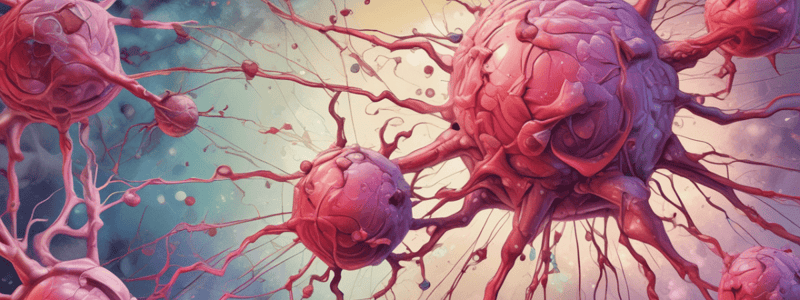Podcast
Questions and Answers
What is a characteristic of Acute Leukemia cells?
What is a characteristic of Acute Leukemia cells?
- Small
- Rigid
- Difficult to identify
- Sticky (correct)
What is the primary treatment for AML/ALL?
What is the primary treatment for AML/ALL?
- Palliative care
- Chemotherapy (correct)
- Surgery
- Radiation therapy
What is the name of the genetic mutation associated with Acute Promyelocytic Leukemia (APML)?
What is the name of the genetic mutation associated with Acute Promyelocytic Leukemia (APML)?
- t(15;17) (correct)
- RAR-B
- BCR-ABL
- t(9;22)
What is the primary risk factor for developing Chronic Myeloid Leukemia (CML)?
What is the primary risk factor for developing Chronic Myeloid Leukemia (CML)?
What is the name of the drug used to treat Chronic Myeloid Leukemia (CML)?
What is the name of the drug used to treat Chronic Myeloid Leukemia (CML)?
What is the primary characteristic of Chronic Lymphoid Leukemia (CLL)?
What is the primary characteristic of Chronic Lymphoid Leukemia (CLL)?
What is the name of the cells associated with Hodgkin's Lymphoma?
What is the name of the cells associated with Hodgkin's Lymphoma?
What is the primary treatment for Non-Hodgkin's Lymphoma?
What is the primary treatment for Non-Hodgkin's Lymphoma?
What is the primary diagnostic method for MALT tumors?
What is the primary diagnostic method for MALT tumors?
Which of the following is a common symptom of Multiple Myeloma?
Which of the following is a common symptom of Multiple Myeloma?
What is the primary risk factor for developing Multiple Myeloma?
What is the primary risk factor for developing Multiple Myeloma?
What is the primary indication for referring a patient to an oncologist for Multiple Myeloma?
What is the primary indication for referring a patient to an oncologist for Multiple Myeloma?
What is the primary goal of treatment for Multiple Myeloma?
What is the primary goal of treatment for Multiple Myeloma?
What is the primary characteristic of cancer cell growth?
What is the primary characteristic of cancer cell growth?
What is the role of autologous transplant in Multiple Myeloma?
What is the role of autologous transplant in Multiple Myeloma?
From which type of cell does myeloma originate?
From which type of cell does myeloma originate?
What is the definition of Myelodysplastic Syndrome?
What is the definition of Myelodysplastic Syndrome?
What is the typical demographic affected by acute leukemia?
What is the typical demographic affected by acute leukemia?
What is the primary indication for assessing a patient for autologous transplant in Multiple Myeloma?
What is the primary indication for assessing a patient for autologous transplant in Multiple Myeloma?
What is the primary reason why acute leukemia is considered dangerous?
What is the primary reason why acute leukemia is considered dangerous?
What is the significance of 'blast' in a CBC?
What is the significance of 'blast' in a CBC?
What is the possible consequence of a high white cell count in acute leukemia?
What is the possible consequence of a high white cell count in acute leukemia?
Which of the following is a rare clinical presentation of acute leukemia?
Which of the following is a rare clinical presentation of acute leukemia?
What is the metabolic abnormality that can occur in acute leukemia?
What is the metabolic abnormality that can occur in acute leukemia?
Flashcards are hidden until you start studying
Study Notes
Hematological Malignancies
- Cancer is defined as uncontrolled cell growth with loss of apoptosis (programmed cell death).
- Cancer can occur in any cell in the body, and when it occurs in blood cells, it is known as either Leukemia (from myeloid or lymphoid cells), Lymphoma (from lymphoid tissue), or Myeloma (from plasma cells).
Leukemia
- Leukemia is classified into acute (rapid progression) and chronic (slow progression) types.
- Acute Leukemia:
- Can be myeloid (AML) or lymphoid (ALL)
- Epidemiology: generally affects older people, non-Hispanic whites, and those with genetic disorders, radiation exposure, or chemical exposure
- Signs and symptoms: fatigue, anemia, high white cell count, bleeding/bruising, bone/joint pains, skin manifestations, and pallor
- Acute Leukemia cells are "sticky" and can cause hyperviscosity, making it a medical emergency
- Treatment: chemotherapy (unless palliative care) and specialized treatment for Acute Promyelocytic Leukemia (APML)
- Chronic Leukemia:
- Chronic Myeloid Leukemia (CML): characterized by Philadelphia chromosome translocation BCR-ABL t(9;22), exposure to ionizing radiation is a risk factor, and treatment involves tyrosine kinase inhibitors
- Chronic Lymphoid Leukemia (CLL): affects older people, smudge cells are present, and treatment involves new drugs in pill form
Lymphomas
- Epidemiology: relatives of probands have a 3.5x higher chance of developing lymphoma, higher incidence in people with RA, hemolytic anemia, Crohn Disease, and motor and Celiac disease
- Hodgkin Lymphoma:
- Peak incidence at young ages (20-24) and old ages (80-84)
- Presents with lymphadenopathy, fatigue, and pruritus
- Treatment: complex chemotherapy, radiation therapy, or a combination of both, and BMT or CART therapy
- Non-Hodgkin Lymphoma:
- Affects all races, ages, and socioeconomic status
- Presents with lymphadenopathy, fever of unknown origin, and can be associated with immunodeficiencies
- Diagnosis: excisional biopsy of the LN (FNA's are notoriously poor), and CBC for anemia, thrombocytopenia, and abnormalities of the WBC count
Plasma Cell Dyscrasias - Multiple Myeloma (MM)
- Multiple Myeloma:
- Epidemiology: higher incidence in African Americans, increases with Body Mass Index, and association with agent orange exposure
- Symptoms: mild back pain, anemia, renal insufficiency, and bone disease
- CRAB criteria: calcium deviation, renal insufficiency, anemia, and bone disease
- Pitfalls: worsening hypercalcemia, increased thirst and urination frequency, confusion, and bone lesions with pathological fractures
- Treatment: induction chemotherapy, autologous transplant, and maintenance therapy (no cure, only prolongs survival)
Myelodysplastic Syndrome (MDS)
- MDS is a premalignant disorder that will be cancer if left untreated
- Defined as a pre-malignancy of the bone marrow
Studying That Suits You
Use AI to generate personalized quizzes and flashcards to suit your learning preferences.


